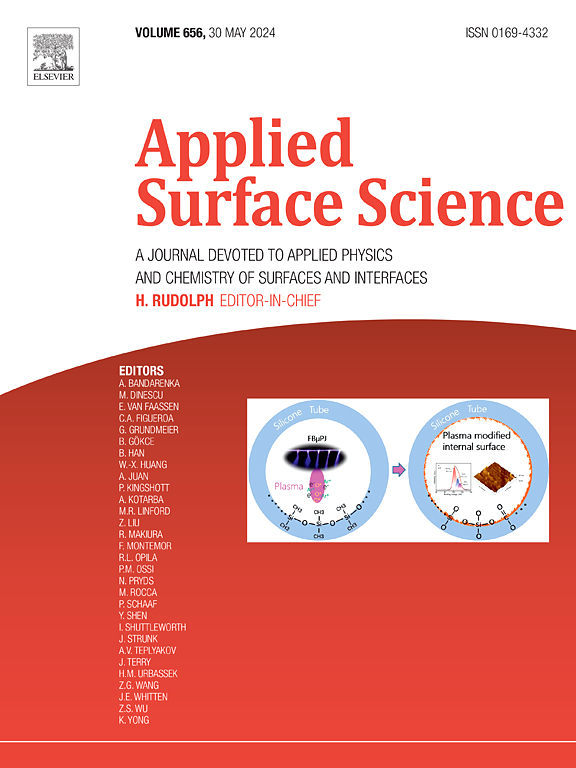提高NiS-Zn3In2S6/Bi2S3的载流子密度和空间解耦效率,促进胺的光催化无受体脱氢
IF 6.9
2区 材料科学
Q2 CHEMISTRY, PHYSICAL
引用次数: 0
摘要
通过光催化无受体脱氢(PAD)将胺转化为氢(H2)和亚胺是一种生产清洁能源和高附加值化学品的可行方法。然而,光催化剂的电荷载流子分离性能较差,以及包括亚胺氢化和 CC 偶联在内的副反应不可控,极大地阻碍了其发展。在此,我们开发了一种异质结光催化剂 NiS-Zn3In2S6/Bi2S3(Ni-ZIS/Bi),用于促进苄胺的 PAD 反应。与 Zn3In2S6 相比,由于光生电荷载流子的密度和空间去耦效力增强,Ni0.5%-ZIS/Bi1.2% 的 H2 和 N-亚苄基苄胺(NBBA)生成率分别提高了 12.4 倍和 5.9 倍。值得注意的是,NBBA 的选择性从 Zn3In2S6 的 28.5% 提高到 NiS0.5%-ZIS/Bi1.2% 的 98%。这项研究为 H2 生产与有机转化过程的合作耦合提供了新的视角。本文章由计算机程序翻译,如有差异,请以英文原文为准。

Enhancing charge carrier density and spatial decoupling effectiveness of NiS-Zn3In2S6/Bi2S3 for boosting photocatalytic acceptorlessdehydrogenation of amines
Photocatalytic Acceptorless Dehydrogenation (PAD) of amines to hydrogen (H2) and imines is a promising approach to produce clean energy and high-value added chemicals. However, the poor charge carrier separation performance of photocatalyst and uncontrolled side reaction, including the imines hydrogenated and C![]() C coupling, significantly hindered its development. Herein, we developed a heterojunction photocatalyst NiS-Zn3In2S6/Bi2S3 (Ni-ZIS/Bi) for boosting the PAD reaction of benzylamine. Due to the enhanced density and spatial decoupling effectiveness of photogenerated charge carriers, Ni0.5%-ZIS/Bi1.2% exhibits 12.4-fold and 5.9-fold increase in production rate of H2 and N-benzylidenebenzylamine (NBBA), respectively, compared with Zn3In2S6. Notably, the selectivity of NBBA increased from 28.5 % of Zn3In2S6 to 98 % of NiS0.5%-ZIS/Bi1.2%. This study offers novel insight into the cooperative coupling of H2 production with organic transformation processes.
C coupling, significantly hindered its development. Herein, we developed a heterojunction photocatalyst NiS-Zn3In2S6/Bi2S3 (Ni-ZIS/Bi) for boosting the PAD reaction of benzylamine. Due to the enhanced density and spatial decoupling effectiveness of photogenerated charge carriers, Ni0.5%-ZIS/Bi1.2% exhibits 12.4-fold and 5.9-fold increase in production rate of H2 and N-benzylidenebenzylamine (NBBA), respectively, compared with Zn3In2S6. Notably, the selectivity of NBBA increased from 28.5 % of Zn3In2S6 to 98 % of NiS0.5%-ZIS/Bi1.2%. This study offers novel insight into the cooperative coupling of H2 production with organic transformation processes.
求助全文
通过发布文献求助,成功后即可免费获取论文全文。
去求助
来源期刊

Applied Surface Science
工程技术-材料科学:膜
CiteScore
12.50
自引率
7.50%
发文量
3393
审稿时长
67 days
期刊介绍:
Applied Surface Science covers topics contributing to a better understanding of surfaces, interfaces, nanostructures and their applications. The journal is concerned with scientific research on the atomic and molecular level of material properties determined with specific surface analytical techniques and/or computational methods, as well as the processing of such structures.
 求助内容:
求助内容: 应助结果提醒方式:
应助结果提醒方式:


